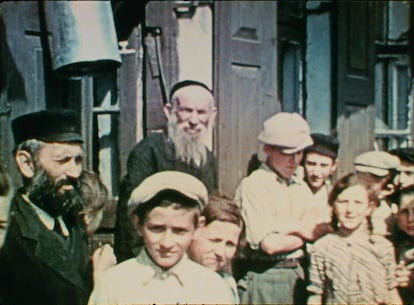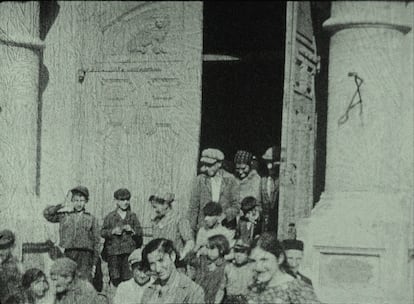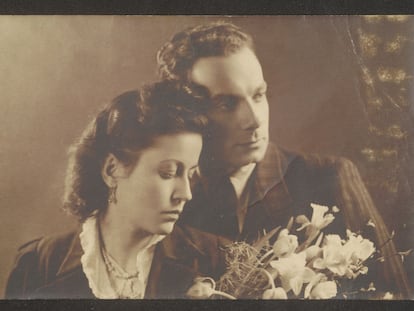The ordinary lives behind the Holocaust
‘Three Minutes: An Exploration’ is based on a home movie that seeks to revive the memory of a world annihilated by Nazism
Children laugh, run and jump in front of the camera. The street and the square are filled with curious onlookers, including the elderly who stand back from the action on the threshold of their homes. There is a grocery store with a woman at the door and a handful of adults who join the children’s games. A family comes out of a restaurant, and a little girl stops to stare at the camera, blocking their way.
These are just some of the images from two rolls of 16-millimeter film of the Jewish quarter of Nasielka, 30 miles from Warsaw – a place that only a year later would be liquidated by the Nazis. Deported in December 1939 to ghettos in different Polish towns, its 3,000 inhabitants ended up in the Treblinka extermination camp. Barely 80 survived.
The brief pre-Holocaust scenes were stumbled upon in 2009 by Glenn Kurtz, the grandson of their author, David Kurtz, concealed within an old toothpaste container. In 1938, his grandfather, a Polish Jew who made his fortune in the United States, had returned on vacation to his hometown armed with an amateur camera. The family owned a DVD copy of the images, but the negative was no more than a solidified piece of matter that Kurtz sent to the US Holocaust Museum in Washington, where it was digitized. What came next is a thrilling story of research and film archeology that inspired first a book by Kurtz’s grandson, and now a film, Three Minutes: An Exploration, by Dutch-born Bianca Stigter. The documentary digs deep to reveal the identity of the subjects who, as Steiger tells EL PAÍS, you want to shout at, telling them, “Get out! Get out of there! Run!”
Released in Spain by Filmin, Three Minutes: An Exploration falls under the umbrella of a project undertaken by the Holocaust Museum’s audiovisual department to recover home movies. Another discovery was a film buried in a basement. Still in the process of restoration and also shot on 16mm film, it captures the trip home of Harry Roher, who also emigrated to the United States. Roher’s origins lay in Mykolaiv, a town near Polish Lviv – now Ukraine – and, like Kurtz, he returned, carrying a camera. Twenty-three minutes are preserved, showing entire families shot in black and white. The subjects are farmers and shopkeepers, men in hats, suits and ties; girls with long braids, bows and white dresses and old women in flowered scarves. They come up to greet the camera, nervous and jovial. Of course, we necessarily observe these images through the lens of what we know. The fate of most of these people was in the Belzec extermination camp, just 60 miles from the village.

Leslie Swift, head of the Holocaust Museum’s audiovisual department, explains the purpose of unearthing these home movies: “Amateur films are essential to complete the historical picture and are finally being seen as primary sources,” he says. “Their account does not form part of the official narrative. They do not belong to the dominant discourse. They are individual accounts and their study and identification is very important because they humanize the narrative.”
Swift explains that key to the success of the project has been the domino effect, and that Roher’s film would never have made it to the museum without Kurtz’s film. “Most of our funding comes from Israel and the United States, but we are very interested in finding films like those unearthed in Latin America, and that is now the challenge we’re facing,” says Swift. “There are hardly any Holocaust survivors left and we are working against the clock, because it’s not just about preserving and restoring. Our goal is to identify as many of the people in these films as possible.”
Instrumental in doing so among the 150 people in the Kurtz film was a woman’s recognition of her 13-year-old grandfather, Moszek Tuchendler, among the children jumping in front of the camera. Tuchendler lived in Florida under the name Maurice Chandler. When the old man first saw the footage, he told his children, “Now you know I didn’t come from Mars.”
Like Tuchendler’s granddaughter, Bianca Stigter first saw the Kurtz images on the museum’s website. “I was struck by the fact that one of them was in color,” she says. “That made it even rarer. The emotions it triggered were mixed; it’s impossible to disassociate what we see from what we know. The weight these films carry is enormous. But above all, I felt that they represent a victory against the attempt to erase an entire culture. Their power is pure. They are ordinary images made extraordinary.”
A culture journalist and former film critic at the Dutch daily NRC Handelsblad, Stigter was offered a commission by the Rotterdam Film Festival, after submitting a free-themed video. It was the embryo of a 70-minute project produced by British filmmaker Steve McQueen that expands the three minutes of archive with the figures that appear in the film, but also through the textures and cracks of the amateur footage that, when examined, is astonishing.
“Home cinema was always something like the ugly duckling of film preservation,” explains Jaime Pena, programmer at the Filmoteca de Galicia and author of Cinema after Auschwitz, a fundamental essay on how modern and contemporary cinema assimilated the images of the concentration camps through their absence. “For obvious and understandable reasons, the first efforts were aimed at recovering and preserving the films on professional terms, made for commercial or artistic purposes,” explains Pena. “But in recent times, home cinema is one of the clearest targets for film libraries: there is a familiar and intimate world hidden within it that documentary films have rarely dealt with, having always prioritized the exceptional and the novel, not to mention fiction.”
The tension between absence and presence turns these home movies into a challenge to oblivion and to those who did their utmost to wipe these people off the map. As Swift explains, these films humanize the victims of the Holocaust because they remind us of the ordinary lives that lay behind the unbearable images that came afterwards and that painted millions of Jews as a malnourished and diseased mass, the walking dead and the merely dead, who were denied a past. The Nazis, in their perverse crusade to exterminate an entire race, confiscated all the home movies treasured by Jewish families. “That’s why every saved recording is a triumph,” Stigter insists. “Jewish history cannot be linked only to death, but also to life, and because of that it is important to know exactly what was destroyed.”

“Of course, it’s a form of victory,” adds Pena. “After all, the task was to erase everything – human lives and any trace of them on Earth. That’s why there are so few testimonies, especially after 1939, and why we barely know the photographs of Auschwitz from the Auschwitz Album [taken by an SS officer and miraculously rescued by the Jewish prisoner Lilly Jacob] or the four clandestine photographs of the Special Squads [the only ones that testify to the extermination in the gas chambers].
“The deportation involved the confiscation of all their belongings, both what they left behind in their homes and what they carried in their suitcases on their way to the concentration camps, which meant the loss of many photographs and amateur film,” adds Pena. “Among the wealthiest Jews, the 9.5mm and perhaps also the 16mm had to be widespread, as in the case of Kurtz, although he came from America; I don’t know if it was so common in Europe. But I think this is a field that will surprise us in the future.”
Swift agrees that this could be the beginning of a fascinating path for a museum whose audiovisual projects were given a kickstart by a generous donation 30 years ago from Steven Spielberg. Among others, the center houses Spectres of the Shoah, the life’s work of director Claude Lanzmann, who collected, with incalculable historical and cinematographic value, testimonies from the most direct witnesses of the Holocaust.
“With the last witnesses gone, we will be left with images that tell us more about what is not there and the contrast with what came after than about the circumstances, even though it is good that they show us that those people were also happy,” says Pena. “In the end, it is the triumph of archival images.”
Sign up for our weekly newsletter to get more English-language news coverage from EL PAÍS USA Edition
Tu suscripción se está usando en otro dispositivo
¿Quieres añadir otro usuario a tu suscripción?
Si continúas leyendo en este dispositivo, no se podrá leer en el otro.
FlechaTu suscripción se está usando en otro dispositivo y solo puedes acceder a EL PAÍS desde un dispositivo a la vez.
Si quieres compartir tu cuenta, cambia tu suscripción a la modalidad Premium, así podrás añadir otro usuario. Cada uno accederá con su propia cuenta de email, lo que os permitirá personalizar vuestra experiencia en EL PAÍS.
¿Tienes una suscripción de empresa? Accede aquí para contratar más cuentas.
En el caso de no saber quién está usando tu cuenta, te recomendamos cambiar tu contraseña aquí.
Si decides continuar compartiendo tu cuenta, este mensaje se mostrará en tu dispositivo y en el de la otra persona que está usando tu cuenta de forma indefinida, afectando a tu experiencia de lectura. Puedes consultar aquí los términos y condiciones de la suscripción digital.
More information
Archived In
Últimas noticias
Most viewed
- Sinaloa Cartel war is taking its toll on Los Chapitos
- Oona Chaplin: ‘I told James Cameron that I was living in a treehouse and starting a permaculture project with a friend’
- Reinhard Genzel, Nobel laureate in physics: ‘One-minute videos will never give you the truth’
- Why the price of coffee has skyrocketed: from Brazilian plantations to specialty coffee houses
- Silver prices are going crazy: This is what’s fueling the rally












































